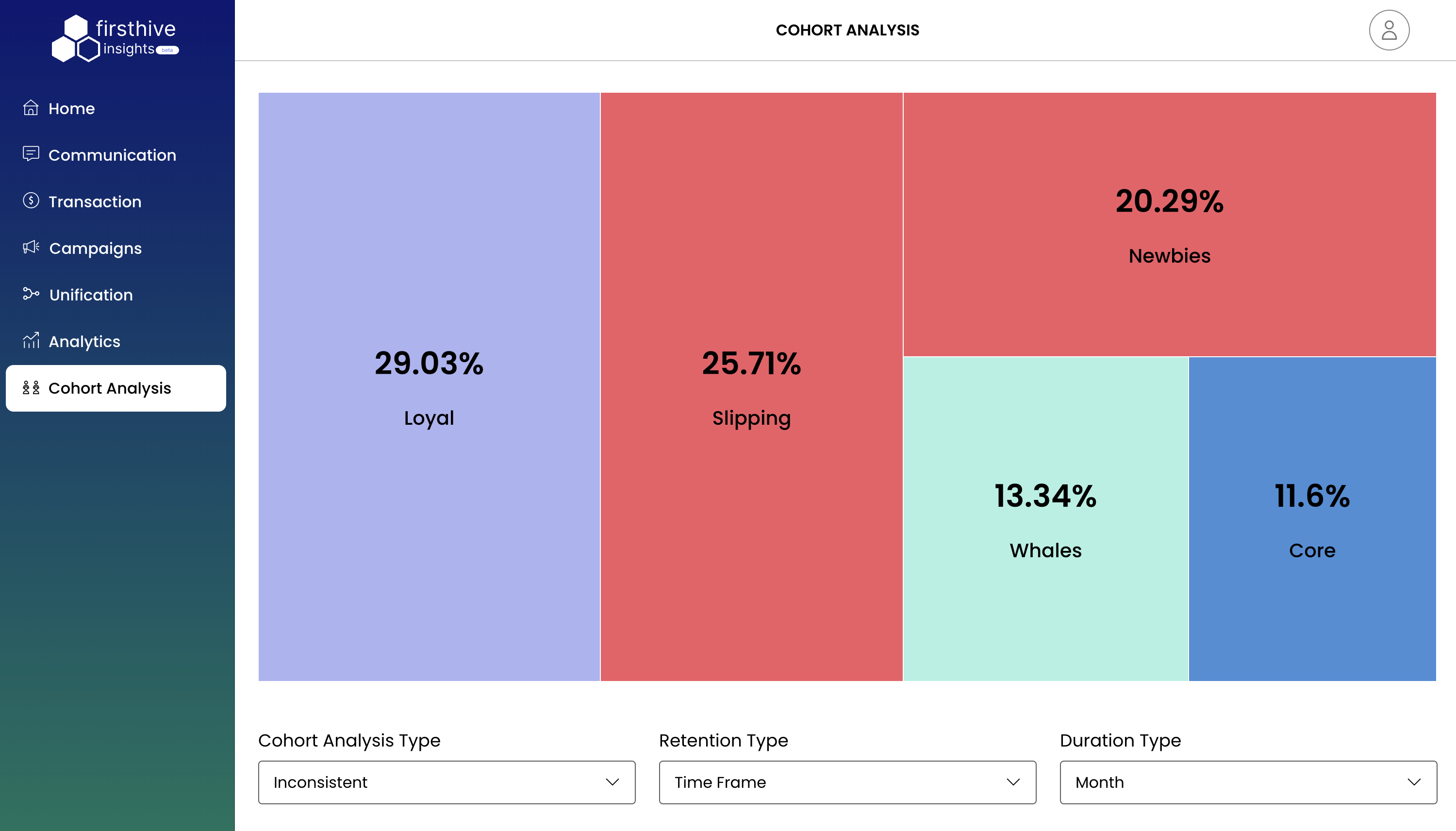Cohort Analysis
Cohort Analysis in FirstHive Insights helps you track customer behavior by grouping users based on shared characteristics or experiences over time. This lets you monitor retention, engagement, and lifecycle patterns to inform business strategy.

What is Cohort Analysis?
Cohort Analysis segments your customers into distinct groups (cohorts) based on common attributes such as acquisition date, first purchase, or behavior. By analyzing these cohorts over time, you can uncover insights about retention, lifetime value, and engagement trends.
Accessing Cohort Analysis
- Log into your FirstHive dashboard and navigate to the Analytics section.
- Select Cohort Analysis from the left menu.
- Your Cohort Analysis dashboard displays customer segmentation data.
Understanding Cohort Categories
FirstHive categorizes customers into six segments for deeper insights:
1. Loyal Customers
- Definition: Customers who consistently engage with your brand and make regular purchases
- Characteristics: High engagement rates, frequent transactions, strong brand affinity
- Business Impact: These customers form your revenue backbone and are likely to recommend your brand
2. Slipping Customers
- Definition: Previously active customers showing declining engagement or purchase frequency
- Characteristics: Reduced transaction frequency, lower engagement metrics, at-risk behavior
- Business Impact: Critical segment requiring immediate attention to prevent churn
3. Newbies
- Definition: Recently acquired customers who are new to your brand
- Characteristics: Limited transaction history, exploring your products/services
- Business Impact: High potential for growth with proper nurturing and onboarding
4. Whales
- Definition: High-value customers who generate significant revenue despite potentially lower frequency
- Characteristics: High transaction values, premium purchases, significant contribution to revenue
- Business Impact: VIP customers requiring special attention and personalized experiences
5. Core Customers
- Definition: Steady, reliable customers who maintain consistent but moderate engagement
- Characteristics: Regular but not exceptional engagement, stable purchase patterns
- Business Impact: Reliable revenue contributors with potential for upselling
6. Churned Customers
- Definition: Customers, who have churned and should be part of reactivation funnel
- Characteristics: Historical engagement trends but no recent transactions or engagements
- Business Impact: Lost revenue, focus for reactivation
Key Features and Benefits
Visual Representation
- Treemap Visualization: Interactive treemap showing proportional representation of each cohort
- Color-coded Segments: Easy identification of different customer categories
- Percentage Breakdown: Clear visibility of cohort distribution
Actionable Insights
- Retention Analysis: Track how customers move between cohorts over time
- Risk Identification: Quickly identify at-risk segments (Slipping customers)
- Growth Opportunities: Spot potential in Newbies and Core customers
- VIP Management: Focus on high-value Whales segment
Using Cohort Analysis for Business Strategy
For Marketing Teams
- Targeted Campaigns: Create specific campaigns for each cohort
- Personalization: Tailor messaging based on cohort characteristics
- Budget Allocation: Optimize marketing spend across different customer segments
For Customer Success Teams
- Proactive Support: Identify and reach out to Slipping customers
- Onboarding Programs: Design specific journeys for Newbies
- VIP Programs: Create exclusive experiences for Whales
For Product Teams
- Feature Development: Understand usage patterns across cohorts
- User Experience: Optimize experiences for different customer maturity levels
- Retention Strategies: Develop features to move customers up the loyalty ladder
Churn Prevention Strategies
Identifying Churn Risk
The Cohort Analysis helps identify potential churn through:
- Slipping Segment Monitoring: Track customers moving from Loyal to Slipping
- Engagement Decline: Monitor decreased activity patterns
- Transaction Frequency: Identify customers with reducing purchase frequency
Churn Category Analysis
- At-Risk Identification: Customers showing declining engagement metrics
- Behavioral Patterns: Understanding triggers that lead to churn
- Intervention Timing: Optimal moments for re-engagement campaigns
Best Practices
Regular Monitoring
- Review cohort distribution weekly or monthly
- Track movement between cohorts over time
- Set up alerts for significant changes in cohort sizes
Segmented Strategies
- Develop unique value propositions for each cohort
- Create cohort-specific communication cadences
- Implement different retention strategies per segment
Performance Measurement
- Track cohort migration patterns
- Measure campaign effectiveness by cohort
- Monitor revenue contribution changes over time
Integration with Other FirstHive Features
Campaign Management
- Use cohort data for targeted campaigns and personalized messaging
- Track performance across segments
Customer Journey Mapping
- Design different journey paths for each cohort
- Optimize touchpoints based on cohort characteristics
- Create cohort-specific automation workflows
Predictive Analytics
- Use historical cohort data for future predictions
- Identify patterns that predict customer behavior
- Optimize customer lifetime value strategies
Troubleshooting and FAQs
Q: How often is cohort data updated?
A: Cohort analysis data is typically updated daily to reflect the most current customer behavior patterns.
Q: Can I customize the cohort definitions?
A: Yes, FirstHive allows customization of cohort parameters based on your specific business metrics and requirements.
Q: How do I export cohort analysis data?
A: Use the export functionality in the Analytics dashboard to download cohort data in various formats (CSV, Excel, PDF).
Q: What’s the minimum data required for accurate cohort analysis?
A: For meaningful insights, we recommend at least 3 months of customer transaction and engagement data.
